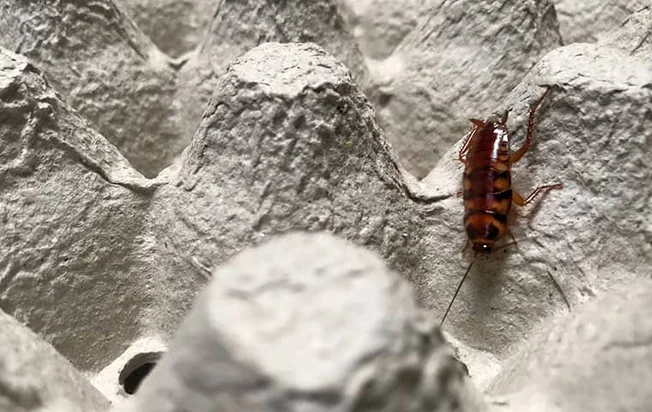What You Need To Know About Cockroaches
Cockroaches are a pest that no homeowners want to ever deal with, but with over 4,000 species living worldwide, at some point, most everyone comes into contact with them. These scavengers feed on a variety of food and non-food items and are able to thrive in almost any indoor or outdoor environment, making them difficult pests to control and avoid.

Frequently Asked Questions About Cockroaches
What are cockroaches?
Cockroaches are invasive and are found in urban, suburban, and rural environments. Cockroaches can become a problem in both homes and businesses. Cockroaches have flattened oval-shaped bodies and six legs that are covered in spines. Their long antennae are usually the same length or longer than their body. Cockroaches are a nocturnal species – hiding during the day and emerging at night to forage for food. Cockroaches are scavengers and feed on a variety of food and non-food items.
Some of the most common cockroach species living in the Dallas, Fort Worth, and Houston areas of Texas are American, brown-banded, German, and Oriental cockroaches.
American cockroaches
American cockroaches are a large species of cockroaches. They have a unique yellowish-colored figure-eight pattern behind their head. American cockroaches are strong fliers.
Brown-banded cockroaches
Brown-banded cockroaches are brown in color, and as their name suggests, they have light brown banding on their wings and across their dark brown bodies. Brown-banded cockroaches have underdeveloped wings and cannot fly.
German cockroaches
German cockroaches are common invaders of both homes and businesses. They are a smaller species of cockroach and have two identifying black stripes that run horizontally down behind their head.
Oriental cockroaches
Oriental cockroaches, or “water bugs”, as they are commonly called, have smooth, shiny bodies, and are black or dark brown in color. They emit a powerful and unpleasant musty smell that helps to identify their presence inside a home.
Are cockroaches dangerous?
Cockroaches are dangerous pests and pose a number of health risks to people. Before finding their way into your home they were traveling in some less-than-sanitary areas, such as garbage piles, drains, sewers, carrion, and excrement. Cockroaches are responsible for spreading a wide range of viruses, bacteria, parasites, and human pathogens that can cause health problems, such as diarrhea, dysentery, and salmonella poisoning. Cockroaches contaminate food sources, utensils, dishes, and the surfaces of a home they have infested with their saliva and excrement. Additionally, cockroaches’ shed skins and feces trigger allergic reactions or asthma attacks in children, the elderly, or people with compromised immune systems.
Why do I have a cockroach problem?
Cockroaches become problematic inside homes because they have found their way inside while foraging for food or because they have been accidentally introduced. Cockroaches regularly move inside through cracks and crevices in the foundation and exterior walls of homes, through spaces underneath doors and around windows, through open windows, through drains and vents, and through spaces around air conditioners. Cockroaches can accidentally be introduced into homes inside deliveries, in used furniture, in used appliances, or in potted plants. They can also be brought inside on people’s clothing or on the bottoms of shoes.
Where will I find cockroaches?
German cockroaches like living inside, especially in homes and restaurants. German roaches hide in warm, humid, dark, secluded places, such as behind appliances or underneath cabinets, in laundry rooms, and in pantry areas. American cockroaches prefer to live outside on trees, in garden areas, underneath mulch, and in sewers and drains. However, they will move inside while searching for food or when the weather outside becomes too hot and dry for their liking. Inside, they nest in humid rooms, including kitchens, bathrooms, and basements. Oriental cockroaches prefer living and nesting in damp, dark places. They are commonly found living in sewers, drains, floor drains, damp basements, and crawlspaces. Brown-banded cockroaches prefer to live in dry locations that are over 80 degrees, such as kitchen and bathroom cabinets, in attics, and underneath furniture.
How do I get rid of cockroaches?
The best way to solve your property’s cockroach problem is to partner with a local pest control company. When you partner with Cantu Pest & Termite, our knowledgeable and friendly professionals will provide the comprehensive services needed to eliminate cockroaches and prevent their return. With over 30 years in the pest control industry, we are proud to provide all of our customers with dependable and affordable home pest control and commercial pest control solutions. To learn more about eliminating cockroaches and other household pests from your Dallas, Fort Worth, Houston, or surrounding area home, reach out to Cantu!
How can I prevent cockroaches in the future?
In addition to our professional pest control services in Dallas, the following tips can help to prevent problems with cockroaches on your Texas property:
- Inspect used appliances and furniture, potted plants, boxes, and packages for cockroaches before bringing them into your home.
- Outside, limit food sources by making sure trashcans and compost bins have tight-fitting lids on them, place gardens a distance away from the outside of your home, pick up uneaten pet food, and maintain outdoor eating areas.
- Inside, limit food sources by keeping all food in the refrigerator or in air-tight containers. Wash dirty dishes daily and regularly vacuum your floors.
- Reduce moisture levels by ensuring that gutters are directing water away from your home, repairing leaky pipes, and using dehumidifiers inside your home.
- Seal as many entry points as possible. Caulk cracks and crevices in the foundation and exterior walls of your home, make sure all screens are intact, place weather stripping around windows and doors, and place door sweeps on all exterior doors.
